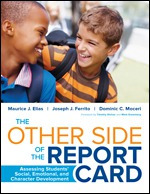The Other Side of the Report Card
Assessing Students' Social, Emotional, and Character Development
- Maurice J. Elias - Rutgers, The State University of New Jersey, USA, Academy for SEL in Schools, The Social-Emotional and Character Development Lab, SEL4US.org
- Joseph J. Ferrito - Graduate School of Applied and Professional Psychology, Rutgers University, Social-Emotional Learning (SEL) Lab
- Dominic C. Moceri - University of Florida, Gainesville (Student), Rutgers, The State University of New Jersey (Student)
Foreword by Timothy Shriver and Mark Greenberg
To better serve the whole child, look at the whole report card.
Students are more than their academic grades—you know it and their parents know it. The progress they make in social-emotional learning and character development is essential to their success in school and in life. But while educators have made great strides in improving grading for academic achievement, we’ve left too many teachers still guessing when it comes to outdated behavior ratings and comment sections.
That’s where this book comes in. Grounded in research and in the author’s work with teachers and administrators, it offers guidance on retooling report cards to better reflect the whole child, integrating SEL and CD into any school- or district-wide grading system. Resources include
- Guided exercises for analyzing existing report cards
- Samples and suggested report card designs
- Tips on improving communication with parents
- Case studies highlighting common challenges
- Testimonials from teachers and students
"When you take report cards to the next level, you make sure that communication reflects all of the important characteristics of success—and ensure that students develop the skills they need for the future. This book brilliantly illuminates the key role played by social-emotional learning in each student’s development and it challenges the tradition of relegating the SEL/EQ observations to the back of the report card. If we want to develop better communities, this book shows the way."
Dr. Neil MacNeill PhD, EdD - Head Master
Ellenbrook Indpendent Primary School
"The ultimate goal of misbehavior is attention. When children don’t get the attention they need through the proper behavior, they will get it any way they can. Children want to be loved and cared about. SEL will help them to learn the proper ways to get attention. It will also help teachers better understand the misbehaviors and redirect students toward positive behavior."
Pamela L. Opel - Teacher, Intervention Specialist
Gulfport School District
Free resources
Connecting SEL to Academic Outcomes
"Skills that students develop in social and emotional learning—empathy, collaboration, and so on—are closely connected to standards in many academic subjects." Read the full article by Mauric Elias, author of The Other Side of the Report Card, on Edutopia.
Blog: How to Assess SES and Character in Report Cards
Read this blog post from one of the authors of The Other Side of the Report Card on how to assess SES and character in Report Cards.

SEL Skill Trajectory
The SEL Skill Trajectory from The Other Side of the Report Card details social-emotional learning (SEL) skill categories and subcategories, and the specific observational behaviors that compose each across the developmental trajectory. (K-12)

The CASEL 5: Definitions and Skills Examples
This table from The Other Side of the Report Card spotlights the most widely accepted definition of SEL, the CASEL 5 (Collaborative for Academic, Social, and Emotional Learning) with detailed definitions and behavioral examples. (K-12)
This book brilliantly illuminates the key role played by social-emotional learning in each student’s development and it challenges the tradition of relegating the SEL/EQ observations to the back of the report card. If we want to develop better communities, this book shows the way.
The ultimate goal of misbehavior is attention. When children don’t get the attention they need through the proper behavior, they will get it any way they can. Children want to be loved and cared about. When teachers incorporate SEL and character development it helps students learn the proper ways to get attention. It will also help teachers better understand the misbehaviors and redirect students toward positive behavior.
"The Other Side of the Report Card is a complete implementation guide to help school districts develop or improve how they convey to families the social, emotional, and character strengths and needs of their children in a culturally appropriate way. With the use of takeaway points, examples, checklists, research, and resources, district teams have the “soup to nuts” process to document that other side of the report card and share information needed to support the success of every student."
"The Other Side of the Report Card by Maurice Elias, Joseph Ferrito, and Dominic Moceri is a rich resource for educators who want to figure out how best to report on students’ social, emotional, and character development. Most teachers are used to simply selecting from a menu of comments to?? describe a student’s behavior on a report card. Dr. Elias et al suggest that it should be much more than that. Rather than simply accepting the premise that “what gets measured is what’s important,” Dr. Elias argues that if it is important, it should be measured. The book is full of examples, research, case studies, and, what I really liked, a nice framework for faculty discussion. Each chapter begins with key takeaways and reflection points that will help focus a faculty committee determined to improve its evaluation system. Chapter 7 is particularly useful as it gives a checklist of important considerations. The authors focus on both SEL and character, acknowledge their differences, but show that each could be part of a school’s evaluation system. As we all strive to educate future citizens and recognize that focusing on academic achievement is not enough, The Other Side of the Report Card looks to be just what educators need to focus and assess on those elements needed for success in school and in life."
Sample Materials & Chapters
Chapter 1 - Is It Realistic to Include Social-Emotional Skills and Character on
